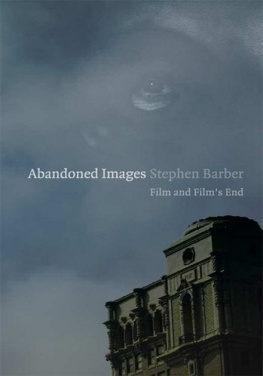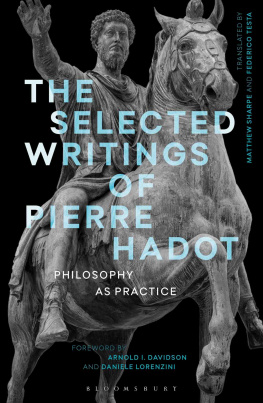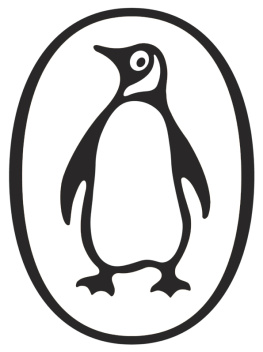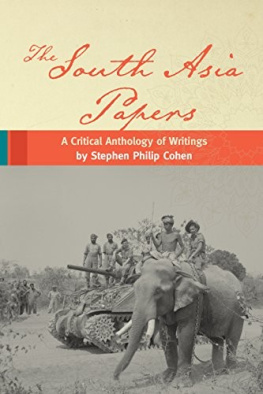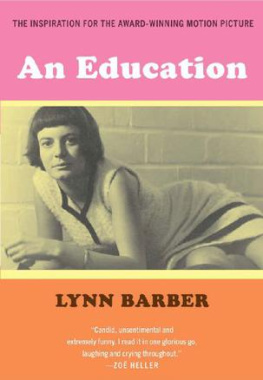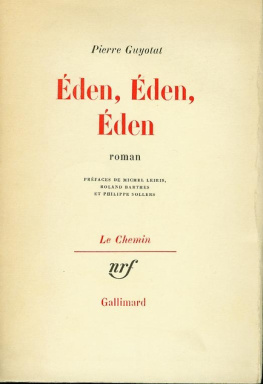Stephen Barber - Guyotat: A Vital Aberration: Writings on Pierre Guyotat 1994-2010
Here you can read online Stephen Barber - Guyotat: A Vital Aberration: Writings on Pierre Guyotat 1994-2010 full text of the book (entire story) in english for free. Download pdf and epub, get meaning, cover and reviews about this ebook. year: 2013, publisher: Elektron Ebooks, genre: Detective and thriller. Description of the work, (preface) as well as reviews are available. Best literature library LitArk.com created for fans of good reading and offers a wide selection of genres:
Romance novel
Science fiction
Adventure
Detective
Science
History
Home and family
Prose
Art
Politics
Computer
Non-fiction
Religion
Business
Children
Humor
Choose a favorite category and find really read worthwhile books. Enjoy immersion in the world of imagination, feel the emotions of the characters or learn something new for yourself, make an fascinating discovery.
- Book:Guyotat: A Vital Aberration: Writings on Pierre Guyotat 1994-2010
- Author:
- Publisher:Elektron Ebooks
- Genre:
- Year:2013
- Rating:3 / 5
- Favourites:Add to favourites
- Your mark:
- 60
- 1
- 2
- 3
- 4
- 5
Guyotat: A Vital Aberration: Writings on Pierre Guyotat 1994-2010: summary, description and annotation
We offer to read an annotation, description, summary or preface (depends on what the author of the book "Guyotat: A Vital Aberration: Writings on Pierre Guyotat 1994-2010" wrote himself). If you haven't found the necessary information about the book — write in the comments, we will try to find it.
Guyotat: A Vital Aberration: Writings on Pierre Guyotat 1994-2010 — read online for free the complete book (whole text) full work
Below is the text of the book, divided by pages. System saving the place of the last page read, allows you to conveniently read the book "Guyotat: A Vital Aberration: Writings on Pierre Guyotat 1994-2010" online for free, without having to search again every time where you left off. Put a bookmark, and you can go to the page where you finished reading at any time.
Font size:
Interval:
Bookmark:
GUYOTAT: A VITAL ABERRATION
BY STEPHEN BARBER
AN EBOOK
ISBN 978-1-909923-24-9
PUBLISHED BY ELEKTRON EBOOKS
COPYRIGHT 2011 ELEKTRON EBOOKS
www.elektron-ebooks.com
No part of this publication may be reproduced, stored in a database or retrieval system, posted on any internet site, or transmitted, in any form, or by any means, electronic, mechanical, photocopying, recording or otherwise, without the prior permission of the copyright holders. Any such copyright infringement of this publication may result in civil prosecution
Pierre Guyotats work is a legendary presence within, and at the periphery of, experimental writing and art, from the 1960s to the contemporary moment. From his novels of the 1960s Tomb for 500,000 Soldiers and Eden, Eden, Eden to his recent books on his own corporeal history, notably Coma, Guyotat has undertaken a relentless exploration of the human body, conflict, sex and social disintegration, which appears unprecedented. At the same time, it exudes the aura of being final work the novelist Edmund White described Guyotat as the last great avant-garde visionary for terminal cultures, worlds and bodies, beyond which only a void remains. Guyotats work is also bound up with immediate, urgent matters: censorship, ecological devastation, all-engulfing prostitution, communism and dictatorial power.
This collection spans a period of sixteen years of writing on Guyotats work, in the form of introductions to translated editions and autonomous texts.
The introductions are those to Eden, Eden, Eden, and Tomb for 500,000 Soldiers, both published by Creation. Both introductions were written very rapidly, in the space of an hour or two. A third translation was planned, of Guyotats 1975 novel Prostitution, but it proved too demanding for the three or four translators who attempted to render it, then abandoned it. Guyotats work has an intricate and delicate translation history an earlier translation, by Helen Lane, of Tomb for 500,000 Soldiers, undertaken soon after its original French publication, was completed but then destroyed, in its sole copy, by the translator herself, as a result of a personal crisis. Guyotats close friend, the theatre director Alain Olliver, told me that Guyotats life would have been very different in terms of its precarious financial situation and his works international status if that earlier translation had been published.
I met Pierre Guyotat for the first time in 1988, while living in Paris for five years for work on my PhD on Artaud, which involved extensive contacts with Artauds close collaborator of his final years, Paule Thvenin. After I had known her for several years, visiting her at her apartment in a former factory in the rue de Reuilly with Artauds drawings on its walls, she recommended that I go and see Pierre Guyotat, who lived nearby, in the boulevard de Charonne. She certainly never believed that Guyotats work had any direct connection to that of Artaud; rather, she saw him as having the same stature and capacity for experimentation. Notably, during the eight years I knew her, until her death in 1993, she never recommended that I visit anyone else, and was more likely to discourage any such visits, with coruscating irony.
Pierre Guyotat was extremely welcoming (certainly solely because of Paule Thvenins recommendation), at his apartment with its extraordinary view over the two eighteenth-century columns of the Barrire du Trne, and we began to meet very regularly, almost daily, for long walks, especially around the periphery of the city, for extended talks: the history of Europe, conflict, film, childhood. In 1990, I moved to Berlin, and he visited me there in 1991, for long walks around the eastern zones of the city at that time, their disintegrating buildings surfaces still skinned-alive and pitted by the assaults of the Soviet armys 1945 incursion into Berlin and by that part of the citys subsequent GDR decades and also to Sachsenhausen concentration camp, north of the city, where his uncle, Hubert, to whom Tomb for 500,000 Soldiers was dedicated, had been killed by the Nazi regime, having been deported from occupied France for his resistance activities; two of these texts give accounts of that visit to Sachsenhausen. The walks around the peripheries of Paris, with occasional transits through its heart, continued when I moved back to Paris, from Japan, for two years, in the summer of 1998; Coma begins with a sequence in which we attended an afternoon performance at the Thtre de lOdon of Balinese dance, by direct descendants of the dancers witnessed by Artaud at the Paris Exposition Coloniale in 1931 (one of the seminal events for his theatre projects of that decade), during the winter of 1999, and then walked through the citys frozen streets under an ultramarine sky.
Those walks continued, as though they had never been interrupted, during a further stay in Paris, in 2006-07, when I finally had the opportunity to read the entire collection of Artauds 406 manuscript notebooks from the final period of his life, for my book Terminal Curses: The Notebooks, 1945-48. That unique opportunity would probably have been impossible without Pierre Guyotats taking me to a reception at the Gallimard family mansion in Paris to introduce me to the Gallimard family and to the archivist of Artauds work at the Bibliothque de France, Guillaume Fau, who had been responsible for the final cataloguing of the notebooks, and who also took over the archiving of Guyotats manuscripts and notebooks.
To coincide with the publication of Eden, Eden, Eden in English, Guyotat made two visits to London, in 1995 and 1996, for readings at the Institute of Contemporary Arts; a conference at Londons French Institute, on the Tel Quel journal, with a focus on Guyotats participation in it, took place in 1995. At that time of relative isolation and neglect, he had not published a book in France since Le Livre and Vivre in 1984, and would not publish again until Prognitures in 2000, after which new books have appeared frequently.
Since his works English language publication had always been a matter of significance to him, those visits appeared important ones for Guyotat; his events were marked by interviews and articles in the UK newspapers, The Guardian and The Independent, and an exhibition of his manuscripts, photographs and films was held to coincide with the first of those visits. Subsequently, in France, from the resurgence of Guyotats publications in 2000, his stature gradually mutated from that of a scandalous writer whose work had been censored and reviled, to a unique, still vitally aberrant figure in European writing and art; one of the texts collected here, on Guyotats involvement with film, was read at a major conference on his work at the Bibliothque de France in 2007. The English language editions of his work (rather than the original editions) proved crucial in being a primary force in generating further recent translations of his work, into Russian, Dutch, Japanese and German, as well as introducing major visual artists, such as Richard Hawkins and the Chapman Brothers, to his work.
(Essay from 1994)
Pierre Guyotats legendary novel of atrocity and extreme obscenity, Eden, Eden, Eden, finally appears in English. Set in the dirt of a tainted zone of the Algerian desert in a time of civil warfare, Guyotats novel brings scenes of brutal violence into intimate collision with relentless acts of prostitutional sex and degradation. Eden, Eden, Eden was banned as pornographic by the French Ministry of the Interior on its publication and remained under governmental censorship for eleven years. The book is a courageous and unique exploration into the virulent matter of sex, language and the human body. It is lethal, and it has no precedent.
Font size:
Interval:
Bookmark:
Similar books «Guyotat: A Vital Aberration: Writings on Pierre Guyotat 1994-2010»
Look at similar books to Guyotat: A Vital Aberration: Writings on Pierre Guyotat 1994-2010. We have selected literature similar in name and meaning in the hope of providing readers with more options to find new, interesting, not yet read works.
Discussion, reviews of the book Guyotat: A Vital Aberration: Writings on Pierre Guyotat 1994-2010 and just readers' own opinions. Leave your comments, write what you think about the work, its meaning or the main characters. Specify what exactly you liked and what you didn't like, and why you think so.


